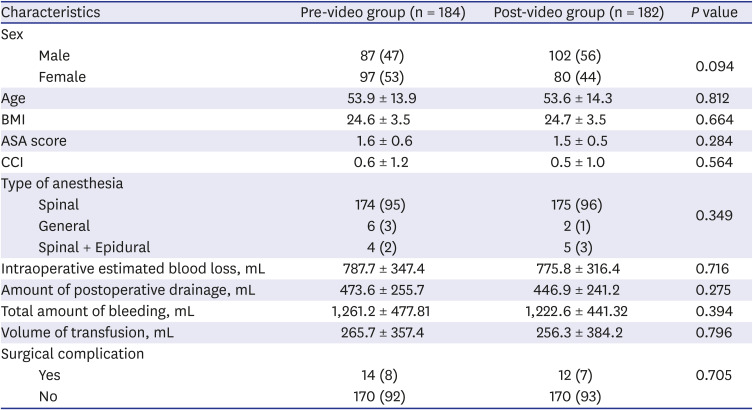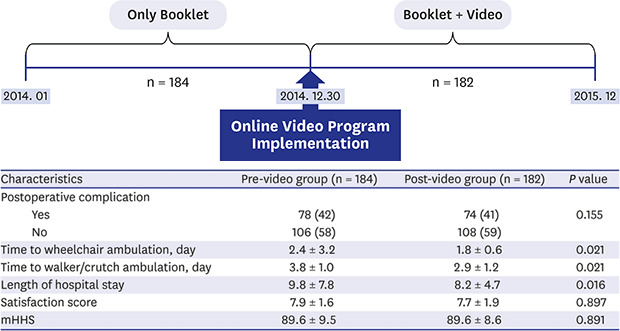1. Learmonth ID, Young C, Rorabeck C. The operation of the century: total hip replacement. Lancet. 2007; 370(9597):1508–1519. PMID:
17964352.

2. Williams JG, Jones JR. Psychophysiological responses to anesthesia and operation. JAMA. 1968; 203(6):415–417. PMID:
5694125.

3. Van Den Eeden YN, De Turck BJ, Van Den Eeden FM. 24 hours stay after hip replacement. Acta Orthop. 2017; 88(1):24–28. PMID:
27658640.

4. Suh YS, Nho JH, Seo J, Jang BW, Park JS. Hip fracture surgery without transfusion in patients with hemoglobin less than 10 g/dL. Clin Orthop Surg. 2021; 13(1):30–36. PMID:
33747375.

5. Lee A, Chui PT, Gin T. Educating patients about anesthesia: a systematic review of randomized controlled trials of media-based interventions. Anesth Analg. 2003; 96(5):1424–1431. PMID:
12707146.

6. Yoo S, Lee KH, Baek H, Ryu B, Chung E, Kim K, et al. Development and User research of a smart bedside station system toward patient-centered healthcare system. J Med Syst. 2015; 39(9):86. PMID:
26208595.

7. Tosounidis TH, Giannoudis VP, Kanakaris NK, Giannoudis PV. The Kocher-Langenbeck approach: state of the art. JBJS Essential Surg Tech. 2018; 8(2):e18.
8. Jlala HA, French JL, Foxall GL, Hardman JG, Bedforth NM. Effect of preoperative multimedia information on perioperative anxiety in patients undergoing procedures under regional anaesthesia. Br J Anaesth. 2010; 104(3):369–374. PMID:
20124283.

9. Shevde K, Panagopoulos G. A survey of 800 patients’ knowledge, attitudes, and concerns regarding anesthesia. Anesth Analg. 1991; 73(2):190–198. PMID:
1854034.

10. Han HS, Lee JY, Kang SB, Chang CB. The relationship between the presence of depressive symptoms and the severity of self-reported knee pain in the middle aged and elderly. Knee Surg Sports Traumatol Arthrosc. 2016; 24(5):1634–1642. PMID:
25982621.

11. Kim KW, Han JW, Cho HJ, Chang CB, Park JH, Lee JJ, et al. Association between comorbid depression and osteoarthritis symptom severity in patients with knee osteoarthritis. J Bone Joint Surg Am. 2011; 93(6):556–563. PMID:
21411706.

12. Xu J, Twiggs J, Parker D, Negus J. The association between anxiety, depression, and locus of control with patient outcomes following total knee arthroplasty. J Arthroplasty. 2020; 35(3):720–724. PMID:
31708293.

13. McGregor AH, Rylands H, Owen A, Doré CJ, Hughes SP. Does preoperative hip rehabilitation advice improve recovery and patient satisfaction? J Arthroplasty. 2004; 19(4):464–468. PMID:
15188105.

14. Jo S, Lee SH, Yoon SJ. Clinical outcomes of total hip arthroplasty for displaced femoral neck fractures in patients 80 years of age and older selected by clinical frailty score. Hip Pelvis. 2020; 32(3):148–155. PMID:
32953707.

15. Kim BS, Lim JY, Ha YC. Recent epidemiology of hip fractures in South Korea. Hip Pelvis. 2020; 32(3):119–124. PMID:
32953703.

16. Bondy LR, Sims N, Schroeder DR, Offord KP, Narr BJ. The effect of anesthetic patient education on preoperative patient anxiety. Reg Anesth Pain Med. 1999; 24(2):158–164. PMID:
10204903.

17. Chen HH, Yeh ML, Yang HJ. Testing the impact of a multimedia video CD of patient-controlled analgesia on pain knowledge and pain relief in patients receiving surgery. Int J Med Inform. 2005; 74(6):437–445. PMID:
15936246.

18. Lin PC, Lin LC, Lin JJ. Comparing the effectiveness of different educational programs for patients with total knee arthroplasty. Orthop Nurs. 1997; 16(5):43–49.

19. McEwen A, Moorthy C, Quantock C, Rose H, Kavanagh R. The effect of videotaped preoperative information on parental anxiety during anesthesia induction for elective pediatric procedures. Paediatr Anaesth. 2007; 17(6):534–539. PMID:
17498014.

20. Wilhelm D, Gillen S, Wirnhier H, Kranzfelder M, Schneider A, Schmidt A, et al. Extended preoperative patient education using a multimedia DVD-impact on patients receiving a laparoscopic cholecystectomy: a randomised controlled trial. Langenbecks Arch Surg. 2009; 394(2):227–233. PMID:
19151995.

21. Heikkinen K, Helena LK, Taina N, Anne K, Sanna S. A comparison of two educational interventions for the cognitive empowerment of ambulatory orthopaedic surgery patients. Patient Educ Couns. 2008; 73(2):272–279. PMID:
18678461.

22. Macario A, Schilling P, Rubio R, Bhalla A, Goodman S. What questions do patients undergoing lower extremity joint replacement surgery have? BMC Health Serv Res. 2003; 3(1):11. PMID:
12823860.

23. Saryeddine T, Levy C, Davis A, Flannery J, Jaglal S, Hurley L, et al. Patient education as a strategy for provider education and engagement: a case study using myJointReplacement.ca. Healthc Q. 2008; 11(1):84–90.

24. Adam JA, Khaw FM, Thomson RG, Gregg PJ, Llewellyn-Thomas HA. Patient decision aids in joint replacement surgery: a literature review and an opinion survey of consultant orthopaedic surgeons. Ann R Coll Surg Engl. 2008; 90(3):198–207. PMID:
18430333.

25. Cheung A, Finegan BA, Torok-Both C, Donnelly-Warner N, Lujic J. A patient information booklet about anesthesiology improves preoperative patient education. Can J Anaesth. 2007; 54(5):355–360. PMID:
17470886.

26. Courtney MJ. The effect of a preanaesthetic information booklet on patient understanding and satisfaction. N Z Med J. 1997; 110(1045):212–214. PMID:
9216606.
27. Louw A, Diener I, Butler DS, Puentedura EJ. Preoperative education addressing postoperative pain in total joint arthroplasty: review of content and educational delivery methods. Physiother Theory Pract. 2013; 29(3):175–194. PMID:
23035767.
28. Kim B, Park S, Park K, Ryoo S. Effects of a surgical ward care protocol following open colon surgery as part of an enhanced recovery after surgery programme. J Clin Nurs. 2017; 26(21-22):3336–3344. PMID:
27982488.

29. Jefford M, Lotfi-Jam K, Baravelli C, Grogan S, Rogers M, Krishnasamy M, et al. Development and pilot testing of a nurse-led posttreatment support package for bowel cancer survivors. Cancer Nurs. 2011; 34(3):E1–10.

30. Heitzmann CA, Merluzzi TV, Jean-Pierre P, Roscoe JA, Kirsh KL, Passik SD. Assessing self-efficacy for coping with cancer: development and psychometric analysis of the brief version of the Cancer Behavior Inventory (CBI-B). Psychooncology. 2011; 20(3):302–312. PMID:
20878830.

31. Ramesh C, Nayak BS, Pai VB, Patil NT, George A, George LS, et al. Effect of preoperative education on postoperative outcomes among patients undergoing cardiac surgery: a systematic review and meta-analysis. J Perianesth Nurs. 2017; 32(6):518–529.e2. PMID:
29157759.

32. Fredericks S, Yau T. Clinical effectiveness of individual patient education in heart surgery patients: a systematic review and meta-analysis. Int J Nurs Stud. 2017; 65:44–53. PMID:
27842225.

33. Friedman AJ, Cosby R, Boyko S, Hatton-Bauer J, Turnbull G. Effective teaching strategies and methods of delivery for patient education: a systematic review and practice guideline recommendations. J Cancer Educ. 2011; 26(1):12–21. PMID:
21161465.

34. Drott J, Vilhelmsson M, Kjellgren K, Berterö C. Experiences with a self-reported mobile phone-based system among patients with colorectal cancer: a qualitative study. JMIR Mhealth Uhealth. 2016; 4(2):e66. PMID:
27282257.








 PDF
PDF Citation
Citation Print
Print




 XML Download
XML Download